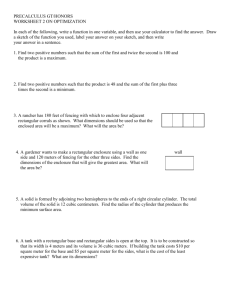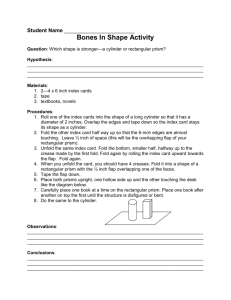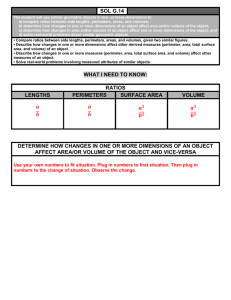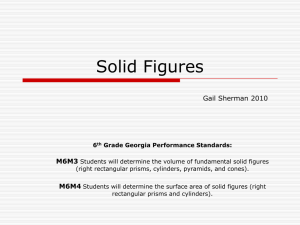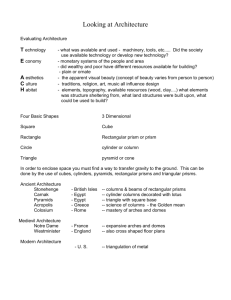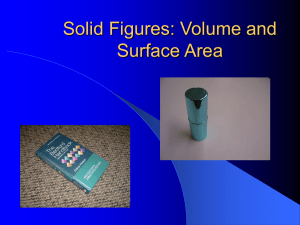Space Station Math
advertisement
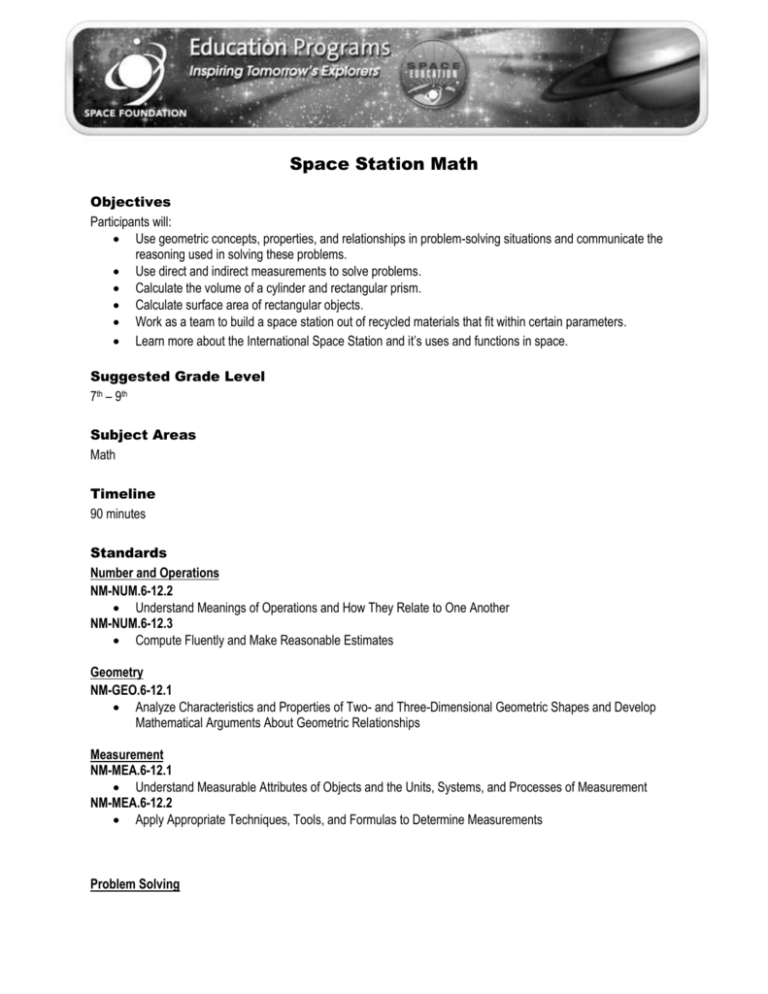
Space Station Math Objectives Participants will: Use geometric concepts, properties, and relationships in problem-solving situations and communicate the reasoning used in solving these problems. Use direct and indirect measurements to solve problems. Calculate the volume of a cylinder and rectangular prism. Calculate surface area of rectangular objects. Work as a team to build a space station out of recycled materials that fit within certain parameters. Learn more about the International Space Station and it’s uses and functions in space. Suggested Grade Level 7th – 9th Subject Areas Math Timeline 90 minutes Standards Number and Operations NM-NUM.6-12.2 Understand Meanings of Operations and How They Relate to One Another NM-NUM.6-12.3 Compute Fluently and Make Reasonable Estimates Geometry NM-GEO.6-12.1 Analyze Characteristics and Properties of Two- and Three-Dimensional Geometric Shapes and Develop Mathematical Arguments About Geometric Relationships Measurement NM-MEA.6-12.1 Understand Measurable Attributes of Objects and the Units, Systems, and Processes of Measurement NM-MEA.6-12.2 Apply Appropriate Techniques, Tools, and Formulas to Determine Measurements Problem Solving NM-PROB.6-12.1 Build New Mathematical Knowledge Through Problem Solving NM-PROB.6-12.2 Solve Problems That Arise in Mathematics and in Other Contexts NM-PROB.6-12.3 Apply and Adapt a Variety of Appropriate Strategies to Solve Problems NM-PROB.6-12.4 Monitor and Reflect on the Process of Mathematical Problem Solving Background The International Space Station (ISS) is an internationally maintained orbiting laboratory that allows scientists a place to study and experiment in low gravity conditions. With minor adjustments, the ISS has been fully assembled. The ISS is very large when compared to previous spacecraft. It will travel at over 27,000 kilometers per hour (17,200 mph) and will operate in orbits between 300-400 kilometers (200-250 miles) above the Earth. The design and construction of the International Space Station takes considerable time and effort. Engineers must consider the size of each of the part of the ISS and also their function and weight. It is truly an international effort of communication to be able to build each module, truss and solar panel individually and then put it together while orbiting in space. Students will use their math knowledge to build their own space station using the ISS as their model. They will learn that common shapes, such as cylinders and rectangular prisms, are used in real world situations. Calculations are necessary for habitat modules, laboratory modules and the solar arrays that provide the energy needed to power their station. Vocabulary International Space Station, habitat, laboratory, cylinder, rectangular prism, volume, area, centimeters Materials Copies of “Build Your own Space Station” PPT on International Space Station Per group: 1 roll of tape One empty soda can One other cylinder such as toilet paper roll or Play Do container, etc… 4 Aluminum foil sheets 1 Flex straw One small empty juice box Six craft sticks 1 ruler Calculator Scissors Lesson 1. First, the presentation on the International Space Station is made to the students to give an idea of what they are trying to build can use http://www.nasa.gov/mission_pages/station/main/index.html And then click on the right-hand side where it says “Interactive Space Station Reference Guide” 2. Tell them that they will be building their own space station, much like the ISS, and it will require certain math criteria. 3. Go over the materials list and the Build Your Own Station Handouts. 4. Review using a ruler and how to find the area of a rectangular object, volume of a cylinder, and volume of a rectangular prism. 5. Students will be put in groups of 3. They will be given a soda can and a toilet paper roll (or other type of cylinder) to represent a habitation module or laboratory module. They will need to calculate the volume of each of these modules. Every Space Station model must have at least one habitation module and one lab module. 6. Each group will receive at least one core module (juice box), which is the “brain” of their station. They will need to calculate the volume of this rectangular prism. 7. There must be at least two photovoltaic arrays for each station. Students will calculate the area of the PVA’s. 8. The photovoltaic arrays harness the Sun’s energy and turn it into electricity. They generate heat while manufacturing this energy, so the space station needs a cooling mechanism called a thermal radiator. Students will build radiators according to the directions on the handout. 9. Now, make sure that they have a design that can be presented to the class. You can use any other supplies to add elements to your space station. Extensions Students can do research on the International Space Station and future space stations. Have them incorporate some of the concepts that they learned into their model. Have the students make presentations to the class on their model. Students research science experiments and present one they find interesting to their class. Evaluation/Assessment Students will be using their handout and they must show their work. Give the students a space station that you built and have them calculate the volume and area of some of the additional modules you put on the space station. Or, as assessment, give the students two different cylinders and rectangular prisms the next day, give these cylinders a space station name like : Destiny Laboratory” and have them calculate volume on their own. . Resources Cosmic Classroom “Maps, Models and Measurement” Module D: 7-10. Space Center Houston Interactive Space Station Reference Guide http://www.nasa.gov/mission_pages/station/main/index.html http://www.nasa.gov/mission_pages/station/structure/index.html Build Your Own Space Station Student Handout Materials List empty soda can toilet paper roll or other cylinder aluminum foil craft sticks flex straws small juice box tape scissors calculator ruler Modules Design 1. Each of the cans represents a module on the Space Station-either the habitation module or the laboratory module. You will need to know the volume of these modules. The volume of a cylinder is πr2h. Let pi=3.14 V= πr2h 1a. For Laboratory Module (where the science experiments are performed) What object did you use to represent this module? __________________ Radius= ___________cm Show your work: Height=___________cm Volume=__________cm3 1b. For the Habitation Module (where the astronauts sleep and eat) What object did you use to represent this module? __________________ Radius= ___________cm Height=___________cm Show your work: Volume=__________cm3 2. The small box you collected represents the core module, where the brain of the space station is located. You will need to know the volume of this module. The volume of a rectangular prism is lwh ( length times width times height) Area= Length ×Width × Height Measurement of box: Show your work: Length=_____________cm Height=_____________ cm Width=_____________ cm Volume=____________cm3 3. There must be two photovoltaic arrays (PVA) on your space station. Use the craft sticks and aluminum foil to make PVA’s. Measure the area of each PVA and record below: Area= Length X Width Area of PVA #1= _____________cm2 Area of PVA #2=______________cm2 4. The photovoltaic arrays harness the sun’s energy and turn it into electricity. They generate heat while manufacturing this energy, so the space station needs a cooling mechanism called a thermal radiator. The second parameter is that the area of the radiators must be ½ the area of the PVA. Also, the radiator must be located next to a PVA. Area of Radiator #1= _________cm2 Area of Radiator #2=__________cm2 5. Now, tape all of your parts together Make a sketch below of your space station and explain the different parts. Add any other component you wish to make your space station unique.

